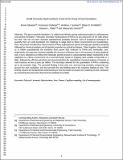Small aromatic hydrocarbons control the onset of soot nucleation
Author(s)
Gleason, Kevin; Carbone, Francesco; Sumner, Andrew J; Drollette, Brian D; Plata, Desiree L; Gomez, Alessandro; ... Show more Show less
DownloadAccepted version (865.4Kb)
Publisher with Creative Commons License
Publisher with Creative Commons License
Creative Commons Attribution
Terms of use
Metadata
Show full item recordAbstract
The gas-to-particle transition is a critical and hitherto poorly understood aspect in carbonaceous soot particle formation. Polycyclic Aromatic Hydrocarbons (PAHs) are key precursors of the solid phase, but their role has not been assessed quantitatively probably because, even if analytical techniques to quantify them are well developed, the challenge to adapt them to flame environments are longstanding. Here, we present simultaneous measurements of forty-eight gaseous species through gas capillary-sampling followed by chemical analysis and of particle properties by optical techniques. Taken together, they enabled us to follow quantitatively the transition from parent fuel molecule to PAHs and, eventually, soot. Importantly, the approach resolved spatially the structure of flames even in the presence of steep gradients and, in turn, allowed us to follow the molecular growth process in unprecedented detail. Noteworthy is the adaptation to a flame environment of a novel technique based on trapping semi-volatile compounds in a filter, followed by off-line extraction and preconcentration for quantitative chemical analyses of species at mole fractions as low as parts per billion. The technique allowed for the quantitation of PAHs containing up to 6 aromatic rings. The principal finding is that only one- and two-ring aromatic compounds can account for soot nucleation, and thus provide the rate-limiting step in the reactions leading to soot. This finding impacts the fundamental understanding of soot formation and eases the modeling of soot nucleation by narrowing the precursors that must be predicted accurately.
Date issued
2020-10Department
Massachusetts Institute of Technology. Department of Civil and Environmental EngineeringJournal
Combustion and Flame
Publisher
Elsevier BV
Citation
Kevin Gleason, Francesco Carbone, Andrew J. Sumner, Brian D. Drollette, Desiree L. Plata, Alessandro Gomez, Small aromatic hydrocarbons control the onset of soot nucleation, Combustion and Flame, Volume 223, 2021 © 2020 The Combustion Institute
Version: Author's final manuscript
ISSN
0010-2180